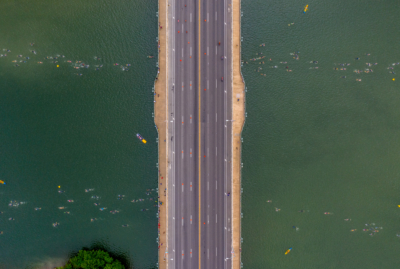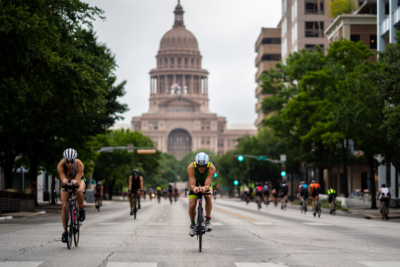The Ascension Seton CapTex Tri and evamor Enhance Partnership
The alkaline water company will hydrate triathletes at the expo and finish line
The Ascension Seton CapTex Tri welcomes evamor for the second year in a row as Official Water sponsor. In addition to providing water to all finishers, the company will keep staff and volunteers hydrated as well as offer the public a chance to try the water at the Health & Fitness expo. CapTex Tri, owned and produced by High Five Events, takes place on Memorial Day, May 29, 2023 in downtown Austin, Texas.
“Our partnership with High Five Events has been seamless and smooth from their hard work behind the scenes. We have the opportunity to reach triathletes of all levels/fitness enthusiasts and their friends and family from Texas and beyond. The evamor team is excited for Memorial Day weekend.” – Brooke Oliver, Field Marketing Manager – TX, OK and LA
The company will provide finish line water for participants of all the triathlon distances once they cross the finish line, and head to celebrate in the finish line festival.
“We’re thrilled that CapTex Tri is partnering up with evamor once again to keep participants hydrated and refreshed at the finish line and expo,” said Megan Frausto, partnership manager of High Five Events. “Their water is the best and we can’t get enough of it. In fact, we drink it all year round at our office. So, we’re positive that our participants will love it too!”
In addition to finish line water, evamor will be handing out their bottles of water at the Health and Fitness expo at Palmer Events Center in Austin on May 28 from 10 AM to 5 PM. Attendees are encouraged to stop by their photo booth for free souvenir photos with the 360 camera that can be shared with friends and family. The expo is free and open to the public.
CapTex Tri celebrated its 30th anniversary last year with a sold out crowd. This year is on track to be the biggest on record. The downtown triathlon offers distances for all levels of athletes from the Rookie and Sprint distances to the Olympic distance tri. In addition, the event offers relays and aquabike, as well as Athena and Clydesdale divisions. CapTex Tri takes place in downtown Austin, Texas on Memorial Day, May 29, 2023 with a Health and Fitness Expo on May 28th. Participant registration can be found HERE. Exhibitor registration is still open for the expo and race day.
About evamor: evamor water comes from a rare, single source protected deep in the Earth— delivering a fresh taste and all-natural, high alkalinity every time.




 There are countless amazing murals around town. We’ve showcased some of our
There are countless amazing murals around town. We’ve showcased some of our  Austin is fortunate to have Town Lake, a massive body of water downtown that offers so much. Now that the sun isn’t blazing hot, it’s time to get out on the water and really enjoy yourself! Whether you’re into kayaking or stand up paddleboarding, there are plenty of places to get started. Pro tip: this is a great way to spend your rest day. No running, but you’re still outdoors, getting a workout, and enjoying the fresh air.
Austin is fortunate to have Town Lake, a massive body of water downtown that offers so much. Now that the sun isn’t blazing hot, it’s time to get out on the water and really enjoy yourself! Whether you’re into kayaking or stand up paddleboarding, there are plenty of places to get started. Pro tip: this is a great way to spend your rest day. No running, but you’re still outdoors, getting a workout, and enjoying the fresh air. From the world-famous Barton Springs Pool and Town Lake Hike and Bike Trail, Austin is known for its green spaces. It’s truly a benefit to our city. Pack a lunch and enjoy a picnic. Finish the book you’ve been reading. Go for a trail run or bike ride. There are so many ways you can enjoy Austin’s parks. Visit the
From the world-famous Barton Springs Pool and Town Lake Hike and Bike Trail, Austin is known for its green spaces. It’s truly a benefit to our city. Pack a lunch and enjoy a picnic. Finish the book you’ve been reading. Go for a trail run or bike ride. There are so many ways you can enjoy Austin’s parks. Visit the  Take your upscale dining outside or enjoy craft cocktails on
Take your upscale dining outside or enjoy craft cocktails on 





